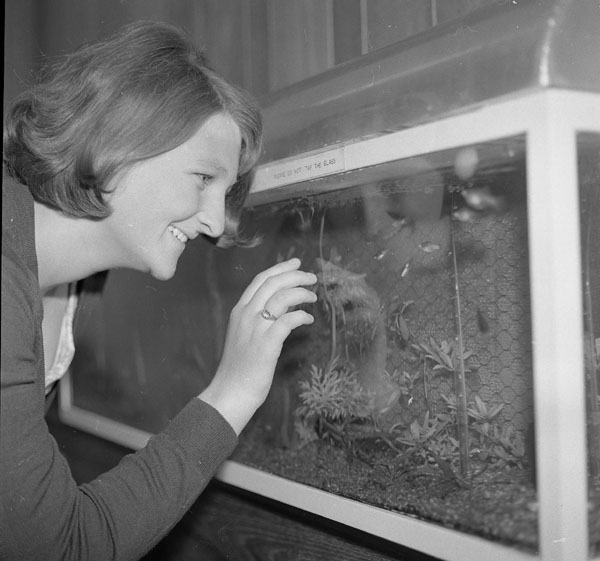

I keep fish as a hobby; and when one day in February another member of our shift suggested having an aquarium in the entrance hall of the Atlas Laboratory, I agreed to help set up the tank and look after the fish. The Director and department Heads were all willing, so work was started and Mr. Roberts (Admin) and his staff were very helpful in setting up the aquarium. A poster describing fish that would live happily together in a community tank was hung on the entrance hall inviting volunteers to buy them. The response was very good - despite requests for Piranhas!

The tank measures 54 ins × 10 ins and is 15 ins high. It holds 29 gallons and has two under-gravel filters. We only have one heater as the tank stands above two radiators but usually a tank of this length needs two to keep the temperature between 78° and 80°F. The fish are fed twice a day by my wife Gaynor (see picture) who also switches the lights on at 8.30 a.m. and off at 5 p.m.
At the moment we have six different types of plants in the aquarium. They are Crypocoryne Echinodorus, Vallisneria, Synnema and Micranthemum, also Aponogeton which has grown very well and has flowered many times. By this time next year the plants should be well settled and growing much thicker and faster.
After having trouble with fin nipping by Tiger Barbs, weak fish dying, and very hard water, the fish are settling down now and the guppys are breeding regularly. None of their fry have survived as there is not yet enough cover for them. A pair of Zebra Danios have spawned (the eggs being eaten), and a pair of Red Platys may soon have some young. These three types of fish are the only ones in the tank at present that will breed there: all the rest must have special conditions to breed. Except for guppys and platys, most of them are egg layers.

Below is a list of the fish we have. A little about them each is headed by the scientific and the popular name of the fish.
The Guppy is one of the best known tropical aquarium fishes. ost of the males are very colourful: no two have the same coloration. The Guppy is a live-bearing fish: it has up to 70 fry a time, and a female is fertile when only three months old.
The Platy is another live-bearing fish, having up to 70 fry a time, but not quite so colourful as the Guppy. There are red and black Platys in the tank.
Zebras are egg-laying fish from India, not so colourful but very active. One pair have spawned in the tank.
As mentioned earlier Tigers tend to nip fins; despite this drawback they are very colourful. Origin Thailand, Sumatra and Borneo.
These little fish look very nice in a school of a dozen or more in a well planted tank. Origin Malaya and Sumatra. Not easy to breed, but when they do they lay their eggs on the under side of leaves.
Black Widows are found in Paraguay. They are egg layers, and very good community fish.
Sometimes called Rio de Janeiro Tetra as they are found in rivers in Rio de Janeiro. We have not got any Flame Tetras yet, but they have been requested.
This very pretty little fish found in Peru and Western Brazil is seen in the community tank in many homes. The rear lower part of the body is red, the throat (as you could call it) is white and a blue/green neon line runs from the eye to the caudal peduncle (base of tail).
Coloration is the only difference between the Glowlight and the Neon: the Glowlight has an orange instead of blue/green line, and the rest of the body is silver. Origin Guiana.
The worker of the tank, origin Thailand, called Sucking Loach because of the sucker around its mouth which enables it to stick to the sides of the tank or leaves of plants. Is a very good scavenger so helping with the maintenance of the tank. Sucking Loach has not been bred in captivity.
A request for a catfish was made so I chose the attractive C Paleatus which often sits at the front glass and amuses onlookers with a frequent wink of the eye. Unfortunately our little catfish died which I was on holiday.
In Siam these fish provided sport, much the same as cock-fighting did in England before it became illegal. The wild Bettas are found in Paddy Fields in Thailand, Cambodia and Indonesia. When breeding, the male Betta builds a bubble-nest at the surface and the eggs are put into this nest and cared for by him. Our Betta died from dropsy only two weeks after we bought him.
Another well known tropical fish, with one drawback: they grow to 5 ins which is twice the size of any other fish in the tank, so we may have to move them and get some smaller ones later.